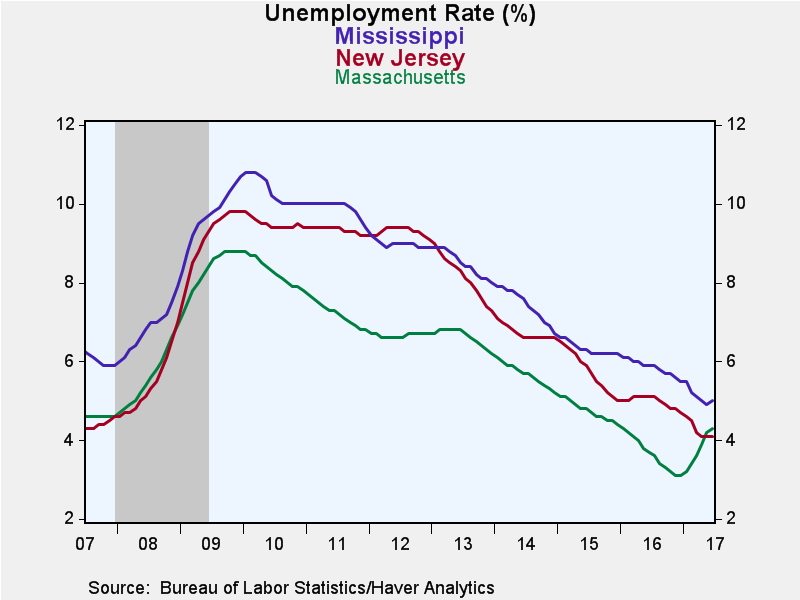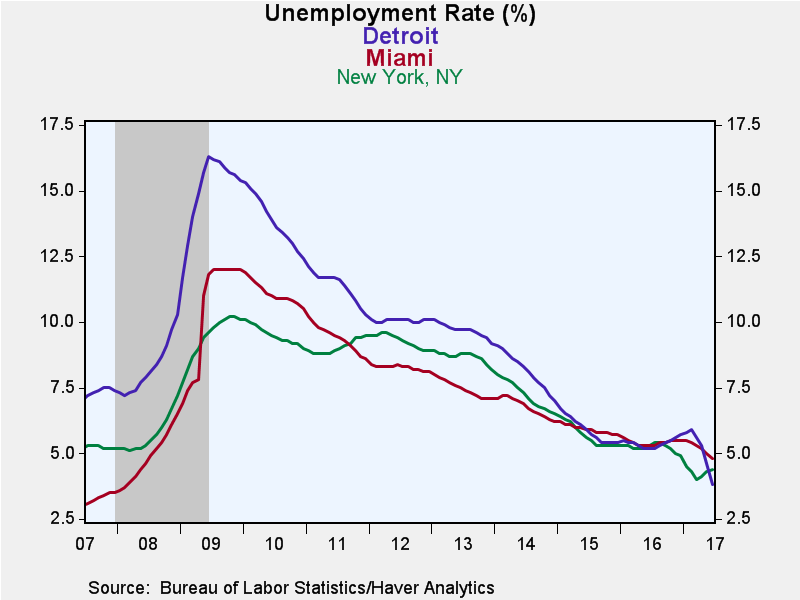 Global| Jul 21 2017
Global| Jul 21 2017U.S. Unemployment Rate Decline Varies Greatly by State
by:Tom Moeller
|in:Economy in Brief
Summary
Unemployment at a 10-year low of 4.5% reflected 1.4% y/y growth in employment and a dampened 0.8% gain in the size of the labor pool. Amongst the states, unemployment continued to be widely divergent. Two states held above the 6.0% [...]
Unemployment at a 10-year low of 4.5% reflected 1.4% y/y growth in employment and a dampened 0.8% gain in the size of the labor pool. Amongst the states, unemployment continued to be widely divergent. Two states held above the 6.0% level while many were 3% or lower.
Alaska's unemployment rate topped the unemployment rate chart at 6.8%. It's been moving higher since the March low of 6.4% as labor force growth outpaced the 1.7% y/y gain in employment. New Mexico's jobless rate also remained high at 6.4%. Employment and labor force growth remain subdued near 1.0%. In Louisiana, the unemployment has fallen to a still high 5.5% as the labor force dipped y/y while employment rose slightly following last year's 1.8% decline. Pennsylvania's unemployment rate of 5.0% was down from 5.5% during the last twelve months and stood near its ten-year low. Employment grew 1.0% y/y versus 0.5% growth in the labor force. In California, the 4.7% jobless rate compared to 12.1% averaged in 2010. Its recent decline reflects 1.1% y/y growth in employment and little y/y change in the size of the labor pool. New York's unemployment rate recently ticked up to 4.5%. Employment grew a quickened 2.0% y/y against accelerated 1.7% growth in the labor force.
At the low end of the unemployment range stood Massachusetts at 4.3% where employment grew 2.7% y/y, the same as the labor force. Unemployment in New Jersey at 4.1% reflected sub-par 1.1% growth in employment; however, the labor force remained little changed y/y, its size down nearly two percent since 2012. Maine's unemployment rate recently rose to 3.5% as employment and labor force growth decelerated. Indiana's jobless rate of 3.0% also was down sharply from a 10.4% high in 2009 as employment grew 1.7% y/y and the labor force held steady y/y. Unemployment in Colorado plummeted to the country's low at 2.3% as 4.1% growth in employment was accompanied by 2.9% growth in the labor force.
 Amongst other large states, Arizona's 5.1% rate of
unemployment reflected 2.9% y/y employment growth and a 2.7% gain in the size of
the labor force. Texas unemployment of 4.6% occurred as employment and the labor
force grew 1.7% y/y. Similarly, North Carolina's unemployment rate of 4.2% was
the lowest since 2000 as employment grew 1.9% y/y against 1.1% labor force
growth. At the low end of the range amongst large states was Wisconsin. It
experienced 3.1% unemployment as employment rose 2.6% y/y, still nearly twice
the growth in the labor force.
Amongst other large states, Arizona's 5.1% rate of
unemployment reflected 2.9% y/y employment growth and a 2.7% gain in the size of
the labor force. Texas unemployment of 4.6% occurred as employment and the labor
force grew 1.7% y/y. Similarly, North Carolina's unemployment rate of 4.2% was
the lowest since 2000 as employment grew 1.9% y/y against 1.1% labor force
growth. At the low end of the range amongst large states was Wisconsin. It
experienced 3.1% unemployment as employment rose 2.6% y/y, still nearly twice
the growth in the labor force.
Within large cities, New York City's 4.4% jobless rate compared to a 2009 high of 10.2%. This past year's rate decline reflected accelerated 4.0% employment growth and a 3.0% y/y gain in the labor force. Unemployment around Chicago of 4.3% was down from a 2010 high of 11.4%. The city's low jobless rate reflected, however, no change in employment this past year set against a 1.6% y/y decline in the labor force. The 4.4% unemployment rate around Los Angeles was the product of 2.5% y/y employment growth and labor force growth of 1.6% y/y. Cleveland's unemployment rate recently increased to 5.9% from 5.0% during all of 2015 as employment was little changed y/y while the labor force grew 1.0% y/y. In Washington state, Seattle's unemployment rate of 3.4% reflected 2.0% y/y employment growth and a 1.3% rise in the labor force.
State unemployment figures are available in Haver's EMPLR database.
| Jun | May | 2016 | 2015 | 2014 | Labor Force | |
|---|---|---|---|---|---|---|
|
Total U.S. Unemployment Rate (%) |
4.5% | 4.7% | 4.8 | 5.3 | 6.2 | 159.5 million |
|
Ten States With Highest Jobless Rate |
||||||
| Alaska | 6.8 | 6.7 | 6.6 | 6.4 | 6.9 | 0.4 |
| New Mexico | 6.4 | 6.6 | 6.7 | 6.5 | 6.7 | 0.9 |
| Louisiana | 5.5 | 5.7 | 6.1 | 6.3 | 6.3 | 2.1 |
| Arizona | 5.1 | 5.1 | 5.2 | 5.9 | 6.7 | 3.2 |
| Pennsylvania | 5.0 | 5.0 | 5.5 | 5.3 | 5.8 | 6.4 |
| Georgia | 4.8 | 4.9 | 5.4 | 5.9 | 7.0 | 4.9 |
| West Virginia | 4.6 | 4.5 | 6.0 | 6.7 | 6.6 | 0.8 |
| California | 4.7 | 4.7 | 5.4 | 6.2 | 7.5 | 19.1 |
| Illinois | 4.7 | 4.6 | 5.9 | 5.9 | 7.0 | 6.5 |
| New York | 4.5 | 4.4 | 4.9 | 5.3 | 6.3 | 9.5 |
| Ten States With Lowest Jobless Rate | ||||||
| Massachusetts | 4.3 | 4.2 | 3.7 | 4.8 | 5.7 | 3.6 |
| New Jersey | 4.1 | 4.1 | 5.0 | 5.8 | 6.7 | 4.5 |
| Minnesota | 3.7 | 3.7 | 3.9 | 3.8 | 4.1 | 3.0 |
| Maine | 3.5 | 3.2 | 3.9 | 4.3 | 5.6 | 0.7 |
| Arkansas | 3.4 | 3.4 | 4.0 | 5.0 | 6.0 | 1.3 |
| Indiana | 3.0 | 3.2 | 4.5 | 4.8 | 5.9 | 3.3 |
| South Dakota | 3.0 | 2.9 | 2.8 | 3.1 | 3.4 | 0.5 |
| New Hampshire | 2.9 | 2.9 | 2.8 | 3.4 | 4.3 | 0.7 |
| Hawaii | 2.7 | 2.7 | 3.0 | 3.6 | 4.4 | 0.7 |
| Colorado | 2.3 | 2.3 | 3.3 | 3.8 | 4.9 | 2.9 |
| Jobless Rate In Other Selected Large States | ||||||
| Arizona | 5.1 | 5.1 | 5.2 | 5.9 | 6.7 | 3.2 |
| Ohio | 5.0 | 4.9 | 5.0 | 4.9 | 5.7 | 5.7 |
| Texas | 4.6 | 4.8 | 4.7 | 4.4 | 5.0 | 13.3 |
| New York | 4.5 | 4.4 | 4.9 | 5.3 | 6.3 | 9.6 |
| North Carolina | 4.2 | 4.5 | 5.1 | 5.7 | 6.2 | 4.9 |
| Florida | 4.1 | 4.3 | 4.9 | 5.3 | 6.2 | 9.8 |
| New Jersey | 4.1 | 4.1 | 5.0 | 5.8 | 6.7 | 4.5 |
| Maryland | 4.1 | 4.2 | 4.3 | 5.0 | 5.8 | 3.2 |
| Michigan | 3.8 | 4.2 | 5.0 | 5.4 | 7.1 | 4.8 |
| Wisconsin | 3.1 | 3.1 | 4.2 | 4.5 | 5.4 | 3.1 |
Tom Moeller
AuthorMore in Author Profile »Prior to joining Haver Analytics in 2000, Mr. Moeller worked as the Economist at Chancellor Capital Management from 1985 to 1999. There, he developed comprehensive economic forecasts and interpreted economic data for equity and fixed income portfolio managers. Also at Chancellor, Mr. Moeller worked as an equity analyst and was responsible for researching and rating companies in the economically sensitive automobile and housing industries for investment in Chancellor’s equity portfolio. Prior to joining Chancellor, Mr. Moeller was an Economist at Citibank from 1979 to 1984. He also analyzed pricing behavior in the metals industry for the Council on Wage and Price Stability in Washington, D.C. In 1999, Mr. Moeller received the award for most accurate forecast from the Forecasters' Club of New York. From 1990 to 1992 he was President of the New York Association for Business Economists. Mr. Moeller earned an M.B.A. in Finance from Fordham University, where he graduated in 1987. He holds a Bachelor of Arts in Economics from George Washington University.












